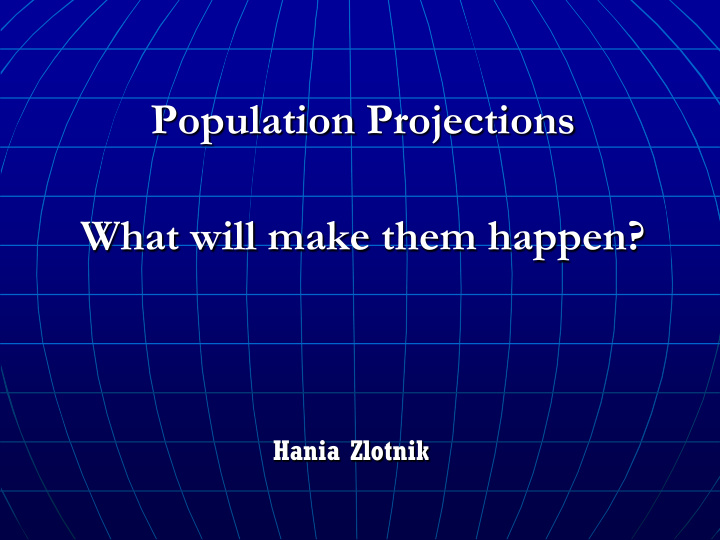



Population Projections What will make them happen? Hania Zlotnik
World population: 1750-2100 18 15.8 billion 16 14 Billions 12 10.1 billion 10 8 7 billion 6 6.2 billion 4 2 2.5 billion 0 1750 1800 1850 1900 1950 1975 2000 2025 2050 2075 2100 Low High Medium
Population by fertility level Level of fertility Population percentage (number of countries) Low (under one daughter per woman) 42 (74) Intermediate (1.0 to 1.5) 40 (65) High (more than 1.5 daughters per woman) 18 (58)
Countries classified by fertility level 18% High fertility 40% Intermediate fertility Low fertility 42% Note : The boundaries shown on this map do not imply official endorsement or acceptance by the United Nations.
Fertility: 1950-2015 8 6.7 Children per woman . 7 High 6 5.4 Intermediate 4.5 5 4 4.4 World 3 2.4 2 Low 1 1.6 0 1950-1955 1955-1960 1960-1965 1965-1970 1970-1975 1975-1980 1980-1985 1985-1990 1990-1995 1995-2000 2000-2005 2005-2010 2010-2015
Projected fertility in the medium variant by group of countries, 2010-2100 8 Children per woman 7 6 Intermediate 4.5 5 High 4 3 2.4 World 2.1 2 1.9 1.6 Low 1 0 1953 1963 1973 1983 1993 2003 2013 2023 2033 2043 2053 2063 2073 2083 2093
Future world population growth will be determined by growth in the high-fertility countries, even if their fertility declines to replacement level by 2100 Annual increment (millions) 50 Intermediate 40 High 2.8 4.9 30 20 2.1 10 Low 0 -10 -20 1950 1960 1970 1980 1990 2000 2010 2020 2030 2040 2050 2060 2070 2080 2090
Use of modern contraceptive methods vs. fertility 90 80 Percentage 70 60 50 40 30 20 10 0 0 1 2 3 4 5 6 7 8 Children per woman Low-fertility Intermediate-fertility High-fertility
Unmet need vs. fertility 50 Percentage 40 30 20 10 0 0 1 2 3 4 5 6 7 8 Children per woman Low-fertility Intermediate fertility High-fertility
Contraceptive use, 1990-2010 Eastern Asia 84 LAC 73 Developed regions 71 South-eastern Asia 63 1990 Northern Africa 63 2010 Caucasus and Central Asia 61 Western Asia 58 Southern Asia 57 Oceania 38 Sub-Saharan Africa 25 0 10 20 30 40 50 60 70 80 90 100
Unmet need for family planning, 1990- 2010 Eastern Asia 3 LAC 10 Northern Africa 11 1990 South-eastern Asia 11 Caucasus and Central Asia 2010 13 Southern Asia 14 Western Asia 15 Oceania 24 Sub-Saharan Africa 26 0 10 20 30 40 50
Years needed to satisfy unmet need at pace set during 1990-2007 160 140 120 100 80 60 40 20 0 Asia LAC East Africa Middle West Africa Oceania Africa
Years to satisfy current unmet need if medium variant is to be reached 60 50 40 30 20 10 0 Africa Asia-North India LAC Asia CIS Africa Years needed at current pace Years desired
Percentage change in per capita donor assistance for family planning programmes among woman aged 15-49, 1996 to 2006 Per capita donor assistance declined Per capita assistance increased (by 50 per cent or more) Per capita donor assistance declined No data available or not applicable (by less than 50 per cent)
Percentage literate among women 100 90 80 70 1990 15+ 60 2009 15+ 50 o 40 1990 15-24 30 2009 15-24 20 10 0 LATAM East Asia and Middle East and South Asia Sub-Saharan Pacific North Africa Africa
Projected millions of pupils in primary, Sub-Saharan Africa 350 300 250 200 150 100 Medium High 50 0 2010 2015 2020 2025 2030 2035 2040 2045 2050
Primary teachers required in Sub-Saharan Africa according to different scenarios 18 16 14 12 Millions 10 8 6 4 2 0 2010 2015 2020 2025 2030 2035 2040 2045 2050 Medium - Constant P/T Medium - Medium P/T Medium - Low P/T High - Constant P/T High - Medium P/T High - Low P/T
www.unpopulation.org
Recommend
More recommend